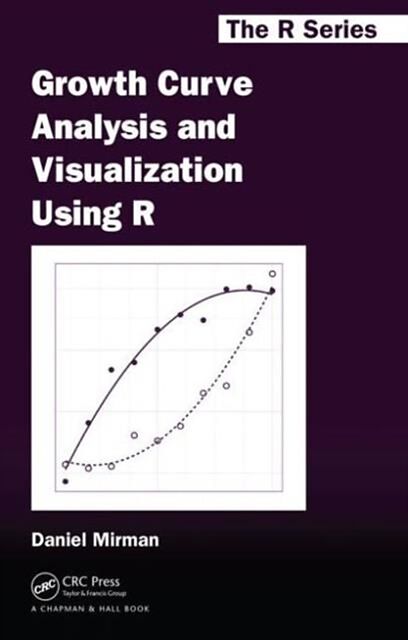Growth Curve Analysis and Visualization Using R
Einband:
Fester Einband
EAN:
9781466584327
Untertitel:
Englisch
Genre:
Mathematik
Autor:
Daniel Mirman
Herausgeber:
Taylor and Francis
Anzahl Seiten:
188
Erscheinungsdatum:
24.02.2014
ISBN:
978-1-4665-8432-7
"This book is intended to be a practical, easy-to-understand guide to carrying out growth curve analysis (multilevel regression) of time course or longitudinal data in the behavioral sciences, particularly cognitive science, cognitive neu- roscience, andpsychology. Multilevel regression is becoming a more and more prominent statistical tool in the behavioral sciences and it is especially useful for time course data, so many researchers know they should use it, but they do not know how to use it. In addition, analysis of individual di erences (de- velopmental, neuropsychological, etc.) is an important subject of behavioral science research but many researchers don't know how to implement analy- sis methods that would help them quantify individual di erences. Multilevel regression provides a statistical framework for quantifying and analyzing indi- vidual di erences in the context of a model of the overall group e ects. There are several excellent, detailed textbooks on multilevel regression, but I believe that many behavioral scientists have neither the time nor the inclination to work through those texts. If you are one of these scientists { if you have time course data and want to use growth curve analysis, but don't know how { then this book is for you. I have tried to avoid statistical theory and techni- cal jargon in favor of focusing on the concrete issue of applying growth curve analysis to behavioral science data and individual di erences"--
" an up-to-date, practical introduction to visualizing and modeling time course and multilevel data. It is particularly well suited to applied researchers in the fields of cognitive science, neuroscience, and linguistics. Virtually no familiarity with R is required (although it helps). Detailed code examples are given using lme4 for linear and logistic growth curve models and ggplot2 for graphing. The writing is clear and easy to follow, without jargon "Joshua F. Wiley, Journal of Statistical Software, June 2014
Autorentext
Mirman, Daniel
Klappentext
This book provides a practical, easy-to-understand guide to carrying out multilevel regression/growth curve analysis (GCA) of time course or longitudinal data in the behavioral sciences, particularly cognitive science, cognitive neuroscience, and psychology. With a minimum of statistical theory and technical jargon, the author focuses on the concrete issue of applying GCA to behavioral science data and individual differences. Throughout the book, R code illustrates how to implement the analyses and generate the graphs. The example datasets, code, and more are available on the author's website.
Zusammenfassung
Learn How to Use Growth Curve Analysis with Your Time Course Data An increasingly prominent statistical tool in the behavioral sciences, multilevel regression offers a statistical framework for analyzing longitudinal or time course data. It also provides a way to quantify and analyze individual differences, such as developmental and neuropsychological, in the context of a model of the overall group effects. To harness the practical aspects of this useful tool, behavioral science researchers need a concise, accessible resource that explains how to implement these analysis methods.Growth Curve Analysis and Visualization Using R provides a practical, easy-to-understand guide to carrying out multilevel regression/growth curve analysis (GCA) of time course or longitudinal data in the behavioral sciences, particularly cognitive science, cognitive neuroscience, and psychology. With a minimum of statistical theory and technical jargon, the author focuses on the concrete issue of applying GCA to behavioral science data and individual differences. The book begins with discussing problems encountered when analyzing time course data, how to visualize time course data using the ggplot2 package, and how to format data for GCA and plotting. It then presents a conceptual overview of GCA and the core analysis syntax using the lme4 package and demonstrates how to plot model fits. The book describes how to deal with change over time that is not linear, how to structure random effects, how GCA and regression use categorical predictors, and how to conduct multiple simultaneous comparisons among different levels of a factor. It also compares the advantages and disadvantages of approaches to implementing logistic and quasi-logistic GCA and discusses how to use GCA to analyze individual differences as both fixed and random effects. The final chapter presents the code for all of the key examples along with samples demonstrating how to report GCA results.Throughout the book, R code illustrates how to implement the analyses and generate the graphs. Each chapter ends with exercises to test your understanding. The example datasets, code for solutions to the exercises, and supplemental code and examples are available on the author's website.
Inhalt
Time Course Data. Conceptual Overview of Growth Curve Analysis. When Change over Time Is Not Linear. Structuring Random Effects. Categorical Predictors. Binary Outcomes: Logistic GCA. Individual Differences. Complete Examples. References. Index.

Leider konnten wir für diesen Artikel keine Preise ermitteln ...
billigbuch.ch sucht jetzt für Sie die besten Angebote ...
Die aktuellen Verkaufspreise von 6 Onlineshops werden in Realtime abgefragt.
Sie können das gewünschte Produkt anschliessend direkt beim Anbieter Ihrer Wahl bestellen.
Loading...
Die aktuellen Verkaufspreise von 6 Onlineshops werden in Realtime abgefragt.
Sie können das gewünschte Produkt anschliessend direkt beim Anbieter Ihrer Wahl bestellen.
| # | Onlineshop | Preis CHF | Versand CHF | Total CHF | ||
|---|---|---|---|---|---|---|
| 1 | Seller | 0.00 | 0.00 | 0.00 |
